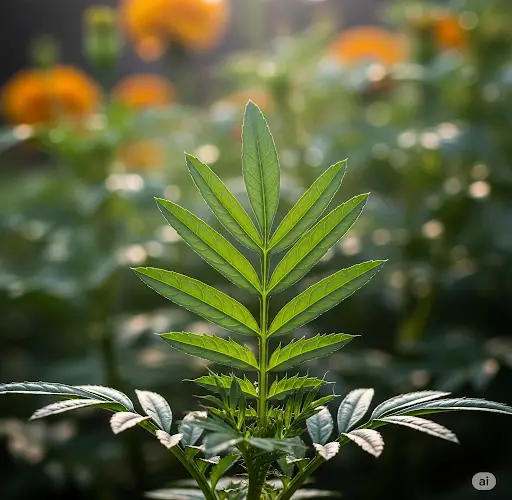Gardeners are always looking for natural ways to improve plant growth and protect their crops from pests. One remarkable solution can be found growing right in the flower bed: marigold leaves. Often admired for their bright, cheerful blooms, marigolds are not just ornamental plants—they hold potent properties that benefit gardens in more ways than one.
This article introduces a simple, natural recipe for making a marigold leaf liquid fertilizer that encourages faster plant growth while acting as an effective, organic pest repellent. Best of all, it’s completely free to make and suitable for all types of home gardens, including vegetable patches, flower beds, and potted plants.
Why Marigold Leaves?
Marigolds (Tagetes species) are known for their ability to deter insects, nematodes, and certain fungal infections. Their leaves contain essential oils and compounds like pyrethrins, which are naturally toxic to many pests but safe for most plants and humans. By turning these leaves into a liquid fertilizer, you unlock a powerful, dual-purpose solution:
-
Boosts plant growth by enhancing soil health and root vitality
-
Repels pests such as aphids, whiteflies, and spider mites
This fertilizer is particularly helpful for vegetables like tomatoes, peppers, and leafy greens, which often suffer from insect attacks during warm seasons.
Benefits of Marigold Leaf Liquid Fertilizer
-
Natural pest control – Marigold compounds deter common garden insects without harming pollinators like bees.
-
Stimulates plant growth – Enriched with beneficial nutrients and microbial activity, the liquid promotes stronger roots and greener leaves.
-
Improves soil quality – The breakdown of organic marigold matter supports healthy microbes in the soil.
-
Safe and sustainable – Unlike chemical pesticides or synthetic fertilizers, this solution is non-toxic and environmentally friendly.
What You’ll Need
To prepare this powerful organic fertilizer and pest repellent, you’ll need:
-
A generous handful of fresh marigold leaves (flowers can be added too)
-
1 liter of clean water
-
A blender or mortar and pestle
-
A clean container with a lid
-
A strainer or cheesecloth
-
Optional: Garlic or chili, to enhance the pest-repelling properties
How to Make Marigold Leaf Liquid Fertilizer
Step 1: Harvest the Leaves
Choose healthy marigold plants and harvest mature leaves. Avoid yellowed or wilted parts. You can also include flowers and young stems, as they contain similar pest-repelling compounds.
Step 2: Crush or Blend the Leaves
Chop the leaves and blend them with a small amount of water to form a thick green paste. If you don’t have a blender, crush them using a mortar and pestle.
Step 3: Add Water and Let It Ferment
Pour the green paste into a container and add the remaining water (around 1 liter total). Stir well and cover the container loosely. Let the mixture ferment for 24–48 hours in a shaded, warm area. Fermentation helps release plant enzymes and activates the natural compounds for maximum effectiveness.
Step 4: Strain the Liquid
After fermentation, strain the mixture using a fine mesh strainer or cheesecloth. The resulting liquid will be a dark greenish-brown color, with a strong herbal aroma.
Step 5: Dilute Before Use
Before applying to plants, dilute the concentrated marigold liquid with water in a 1:3 ratio (1 part marigold solution to 3 parts water). This prevents any risk of leaf burn, especially on sensitive plants.
How to Apply
-
As a foliar spray: Pour the diluted liquid into a spray bottle and mist the leaves, especially the undersides where pests tend to hide.
-
As a soil drench: Pour around the base of plants to nourish the roots and ward off soil-dwelling pests.
Use the spray once a week during the growing season or after heavy rainfall, which can wash away natural defenses.
Ideal Crops for Marigold Leaf Fertilizer
This liquid works exceptionally well for:
-
Tomatoes and peppers – Repels whiteflies and aphids
-
Leafy greens – Prevents caterpillar infestations
-
Ornamentals and potted plants – Boosts growth and protects against mites
-
Herbs – Keeps insects away without affecting flavor
Tips for Best Results
-
Always test on a small area of the plant first, especially for delicate species, to ensure no adverse reaction.
-
Apply in early morning or late afternoon, when sunlight is less intense, to avoid scorching leaves.
-
Use fresh batches each time. Since the liquid is fermented, it’s best to use it within 3 days.
-
Combine with garlic, onion, or chili in the blending step to enhance its repellent action.
A Natural Solution for a Thriving Garden
Nature often provides the best solutions, and marigold leaf fertilizer is a shining example. With minimal effort and no expense, you can prepare a multipurpose liquid that strengthens your plants and keeps harmful pests at bay. Whether you’re a home gardener or tending to a small farm, this marigold-based solution offers a reliable, eco-friendly alternative to synthetic chemicals.
Try it out this season and enjoy a healthier, more productive garden—naturally.



